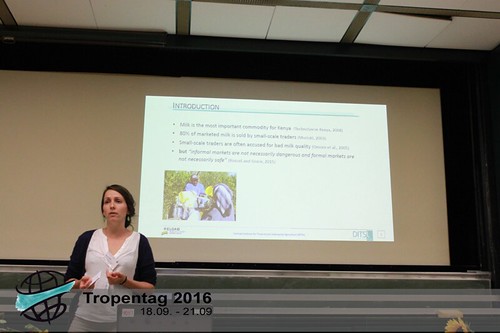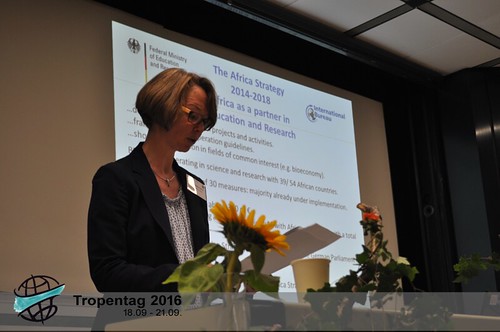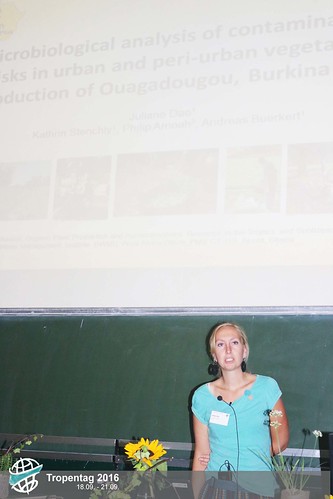Oral presentations 2016
Toxins in Tropical Food Production
Wed, 09/21/2016 - 16:04 — BackhausDo you know what rice consumption in Nigeria and milk consumption in Kenya have in common? It’s something that both livestock and crop farmers, especially in developing countries, have to deal with: the risk of exposure to mycotoxins in food. One could hear about this topic today, last day of Tropentag 2016, in the fourth oral presentation about food security and nutrition, as well as yesterday in the third poster session about mobile dryland pastoralism. I had the chance to hear both Olusegun O. Atanda’s and Caroline Makau’s research results about such an issue on food safety, which is considered as a specific problem of tropical regions. Exposure to mycotoxins, in fact, should be as low as possible since these are genotoxic and carcinogenic.
In Kenya, aflatoxins (a type of mycotoxin produced by Aspergillus, a species of fungus) pose a safety risk in cow milk. Research revealed that this resulted from poor feed storage and on field infestation during plant growth, which then contaminated animal feeds and finally ended up in the milk. Caroline Makau stated that especially rotten maize cobs used as ingredients in on-farm formulated feeds caused this problem, and that contamination was especially high in peri-urban farms.
Olusegun Atanda’s study is mainly a call for doing more large-scale research and for stressing the need to continually monitor mycotoxin levels in rice. As it seems, this subject is worth being followed in the future.
Fertilizer or cash? What is the best subsidy and for whom is it?
Wed, 09/21/2016 - 12:53 — MichelaThe study used different sets of choices as possible options to be picked by the farmers. Set A, for example, offered the possibility to choose either 50 dollars or 100kg fertilizer.
The study interviewed 808 households and led to results showing that, in most cases, one's preference would always anyway go for a subsidy, no matter in what form.
Result:
And still, the farmer would rather opt for cash depending on the expenses he has. Namely, school fees for children, health insurance, rent.
Implication for policy-makers:
One of the proposed conclusions on the solutions that may improve the support given to farmers focused on the distribution of fertilizer as a subsidy instead of mere money. In the long-term, this could in fact increase the benefits resulting from its usage.
Delivering wind energy to small-scale farmers in Argentina: why did it fail?
Wed, 09/21/2016 - 12:17 — PoscherIn one of these researched areas, 80% of the systems were not running anymore.
What happened?
-Broken blades due to the very strong local wind: an inadequate system for this area.
-Batteries ran flat because of no additional power sources
-Other technical breaks: problem arose because efficient over effective systems were chosen
Social/local reasons:
-It was not possible to repair the systems. Spare parts were far away located, young people moved to the cities leading to a lack of knowledge for maintaining and repairing the systems.
-Forbidden maintenance the systems. Farmers as end-users but not as owners.
-Fund of the project did not reach the farmers and the study site. Furthermore, equipment was stolen by farmers who pretended to be government officials.
Malawi in the future: will people be able to keep cooking?
Wed, 09/21/2016 - 11:40 — PoscherThe main driving force of an increasing demand was identified to be the strong population growth in Malawi. Through modeling the demand and supply for the future, a big gap between the two was found, threatening the biomass availability. Even though other (not yet used) sources like crop residues may be used in the future, the demand will still exceed the supply up to a very high extent.
What is the government doing? Is it enough to ensure enough fuel for the Malawian people in the future?
The answer, given by the research, is that the planned methods will not be sufficient. The main strategy is the provision of efficient cooking stows to decrease the amount of fuel needed for cooking. The different models, with an optimistic and pessimistic scenarios, showed that, even with a high acceptance of the cooking stows, the supply gap remains.
Despite this finding, the research went further and provided a solution: different, individualizable agroforestry systems to include woody biomass in the farms to increase the fuelwood supply.
From the eyes of a small-scale milk trader: how to improve the milk value chain?
Wed, 09/21/2016 - 09:48 — PoscherYou are facing quite lots of difficulties, and if the quality of the milk is bad, you cannot sell it anymore. You bear the risks, you lose money if the milk gets bad. Controlling the product by smell, taste, texture and density without technical support needs much expertise.
Traveling to the producers, controlling and keeping the quality to resell to milk stations is certainly a hard job. So, how to improve the situation?
 The presented research takes a closer look at those limitations and possibilities for improving the situation of small-scale milk trading from the perspective of a local milk trader. What are the results?
The presented research takes a closer look at those limitations and possibilities for improving the situation of small-scale milk trading from the perspective of a local milk trader. What are the results?
BMBF promote Research for development-innovative partnership
Wed, 09/21/2016 - 09:23 — Kootlole As some BMBF representative reported, the Ministry has a fund of 350 millions euros to be allocated by 2019. In 2016, they have funded about 300 projects together with African partners with a total budget of about 60 million euros, promoting the research in the area of health and medicine and climate change, energy and food production.
As some BMBF representative reported, the Ministry has a fund of 350 millions euros to be allocated by 2019. In 2016, they have funded about 300 projects together with African partners with a total budget of about 60 million euros, promoting the research in the area of health and medicine and climate change, energy and food production. Climate Change and Our Beloved Fruit Trees
Tue, 09/20/2016 - 18:42 — ElsbyA concerning fact that stood out during the presentation on lettuce contamination in Burkina Faso along the value chain was that 70% of the water being assessed in the study was above the safety or “health based target” threshold as set out by the World Health Organization. This water is being used to irrigate crops in urban and peri-urban locations, and is often derived from sewage contaminated sources.
Lettuce is an important crop in this area as it is considered “exotic” and has high value, especially during wedding season and other important occasions. Conserving its hygiene along the value chain is critical in preventing the food-borne illnesses that are all too frequent when using coliform-polluted water as an irrigation source.
Science and Practice – A Complex Relationship
Tue, 09/20/2016 - 17:30 — LangIn this year’s GIZ/EZ session, the linkages and the connectivity between research and development was discussed. How much research is necessary, and what type of knowledge and partnerships are needed to reach the final beneficiaries? - was the main question that arose their symposium.








